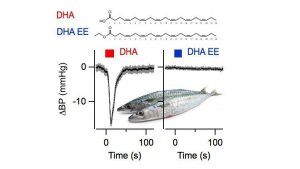Omega-3 fatty acids lower blood pressure
Blood pressure recordings on anesthesized mice upon injection of DHA and DHA EE (experiments performed by Bianka Wissuwa).
Illustration: FSU BiophysikLong-chain polyunsaturated omega-3 fatty acids such as docosahexaenoic acid (DHA), found abundantly in oily fish, may have diverse health-promoting effects, potentially protecting the immune, nervous, and cardiovascular system. In a collaboration within FOR 1738Externer Link (groups of Hoshi – UPenn, Bauer – CSCC, Heinemann – CMB) we report here that DHA directly and reversibly activates BK channels in a tissue-specific manner mediated by the type of auxiliary β subunit present. By means of BK-channel opening, DHA lowers blood pressure in wild-type but not in Slo1 knockout mice. DHA ethyl ester (DHA EE), contained in dietary supplements, not only fails to activate BK channels but is also antagonistic. Slo1 BK channels are thus receptors (500 nM) for long-chain omega-3 fatty acids, and these fatty acids – unlike their ethyl ester derivatives – activate the channels and lower blood pressure. This finding has practical implications for the use of omega-3 fatty acids as nutraceuticals for the general public and also for the critically ill receiving omega-3 enriched formulas.
